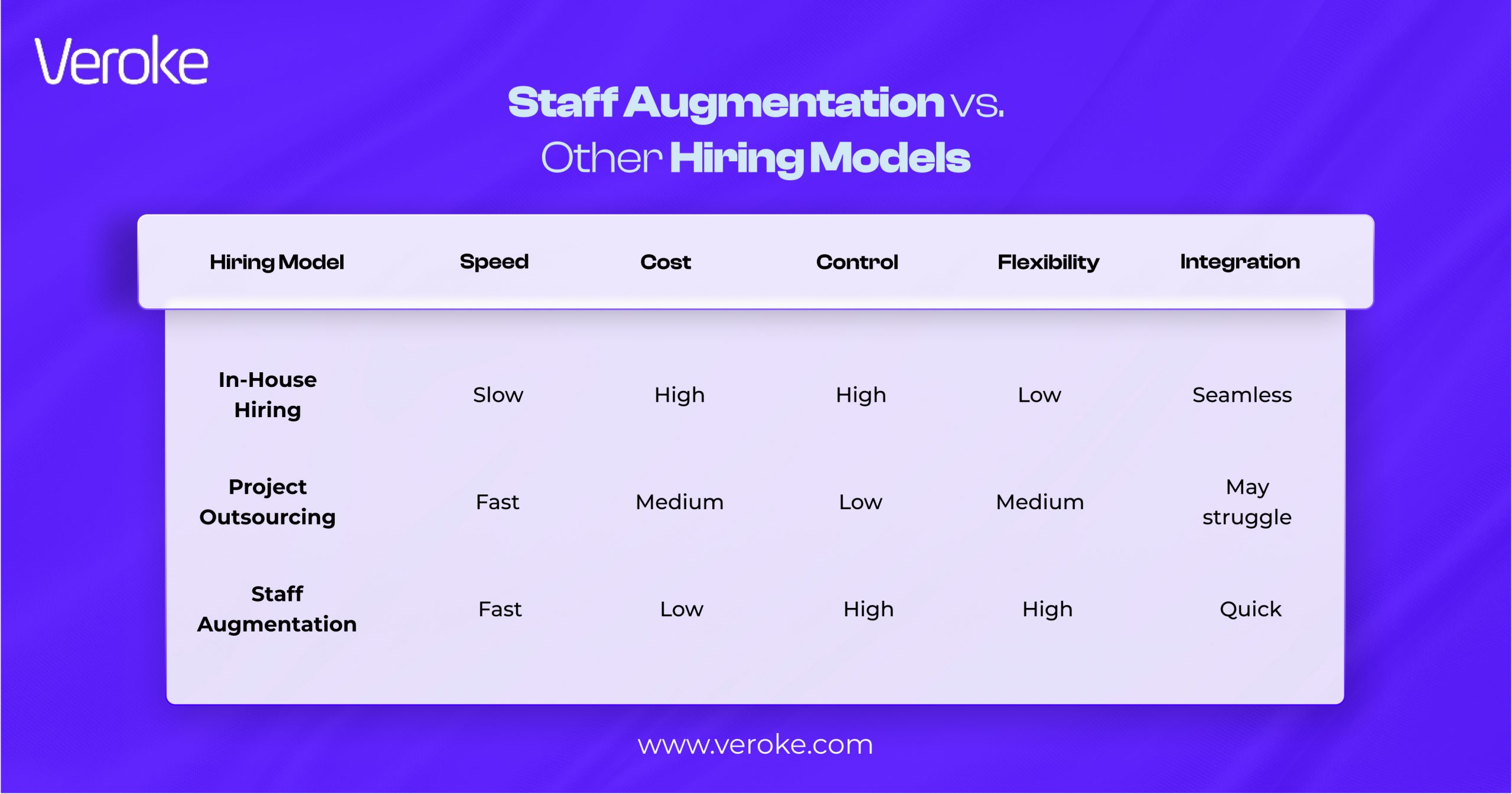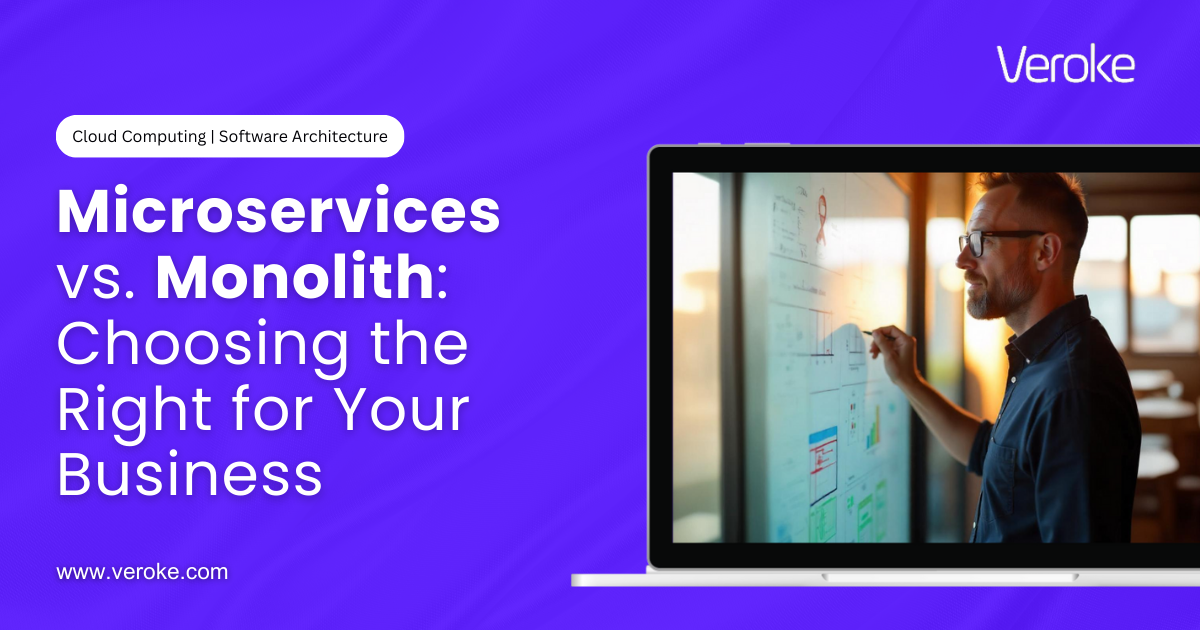Overview
Subscribe to Our Newsletter
Get expert guidance on various topics, resources, and exclusive insights
How IT Staff Augmentation Supercharges Your Tech Team?
Whether you need IT experts to boost your tech capabilities or cost-effective nearshore talent, IT staff augmentation helps you adapt swiftly to market demands.
It’s how modern businesses supercharge their tech teams, adding speed, versatility, and expertise when you need it, without the burden of traditional hiring.
In this dynamic environment, agility is essential for staying competitive. Whether you’re a startup building an MVP or an enterprise undergoing digital transformation, scaling your technology team can make all the difference.
The IT staff augmentation service market is experiencing rapid growth, valued at USD 299.3 billion in 2023 and projected to reach USD 857.2 billion by 2031, at a 13.2% CAGR. This surge signals a major shift in how companies build, scale, and optimize their tech functions.
This surge signals a major shift in how companies build, scale, and optimize their tech functions.
But what does staff augmentation look like in practice? How do companies leverage it effectively, and what are the real advantages compared to traditional hiring or outsourcing?
Let’s break it down.
What Exactly Is IT Staff Augmentation?
IT staff augmentation is a strategic outsourcing model that enables companies to temporarily hire skilled tech professionals to strengthen their in-house teams.
These external experts fill specific talent gaps, increase development capacity, and accelerate project timelines, without the overhead of permanent hires.
Unlike traditional outsourcing, where entire projects are handed off to a third party, IT staff augmentation keeps you in control.
The augmented personnel work seamlessly alongside your internal teams, follow your processes, use your tools, and report directly to your managers.
Key Features of IT Staff Augmentation Services
Here’s why staff augmentation is the ultimate tool for scaling and strengthening your tech team:

Key features of IT Staff Augmentation Services
⤷ Scale Your Team Instantly
With IT staff augmentation, you can scale your team up or down exactly when project demands change—no long-term hiring commitments required.
⤷ Access Specialized Expertise
It lets you tap into niche skills, cloud architects, AI engineers, UI/UX designers—precisely when you need them.
⤷ Optimize Your Budget
By paying only for active contributions, you eliminate recruitment fees, benefits overhead, and unused salary costs.
⤷ Accelerate Your Onboarding
Onboarding is fast, taking only days instead of weeks, so your sprints stay on schedule and your roadmap is unaffected.
⤷ Maintain Full Control
You maintain complete control over priorities, tools, and quality; the augmented team uses your processes, not a rigid external system.
⤷ Tap into Global Talent
Leveraging a worldwide talent pool breaks geographic constraints, so you always get the best fit in skills and experience.
⤷ Enjoy Flexible Contracts
Contracts adapt to your needs—whether you need one developer for a month or a full scrum team for a year.
⤷ Ensure Seamless Integration
Augmented professionals embed themselves in your workflows, culture, and communication channels as true extensions of your team.
Why Companies Choose Staff Augmentation?
IT staff augmentation isn’t just a trend, it’s a practical response to the evolving challenges.
As businesses strive to stay competitive and innovate faster, this model offers a powerful way to close skill gaps, reduce costs, and accelerate time-to-market.
Here’s why more and more companies, from agile startups to global enterprises, are embracing staff augmentation:
1. Solving Skill Shortages
When your local talent pool can’t keep up with the demand for AI/ML engineers, DevOps specialists, cybersecurity analysts, and blockchain developers, staff augmentation steps in.
By tapping into a global network of vetted professionals, you gain on-demand expertise, filling critical roles swiftly and sidestepping lengthy recruitment cycles.
2. Faster Time-to-Market
In the race to innovate, speed is non-negotiable. Staff augmentation allows you to scale your team instantly, speeding up development cycles and getting your product to market faster.
With more hands on deck, bottlenecks shrink, sprints move faster, and deliverables are completed on time (or ahead of schedule).
3. Cost Efficiency
Hiring full-time employees comes with overheads: salaries, benefits, training, office space, and long-term liabilities.
With staff augmentation, you can engage talent on demand and avoid these additional costs. You pay only for what you need, when you need it.
4. Scalability
Project requirements can shift fast. One month you need ten developers, the next you might only need three.
With staff augmentation services, you can scale your team up or down based on your requirements, with no messy offboarding or long-term commitments.
5. Reduced Project Risk
Bringing in seasoned professionals can significantly lower the risks associated with complex or time-sensitive projects.
Augmented staff are typically experienced in hitting the ground running, which leads to fewer errors, smoother integrations, and more consistent performance.
How IT Staff Augmentation Enhances Your Tech Team's Performance?
Now that we’ve covered why businesses are turning to staff augmentation, let’s dive into how this model actively enhances your tech team’s performance, agility, and output.
Here are the key ways augmenting your team can elevate your entire development lifecycle:
1. Enhanced Agility
Adaptability is at the core of everything in this evolving tech world. With staff augmentation, you gain the flexibility to respond quickly to shifting priorities, evolving technologies, or urgent deadlines.
Whether you’re pivoting a product strategy or scaling up for a high-stakes release, having instant access to skilled professionals allows you to move fast and smart.
2. Access to Specialized Expertise
Every project has its unique challenges, be it cloud migration, cybersecurity upgrades, or front-end optimization.
Staff augmentation allows you to bring in niche talent. From Kubernetes experts to AR/VR developers, you can source world-class specialists who deliver results without the wait.
3. Increased Productivity
With a reinforced tech team, your development capacity expands without overwhelming your core staff.
While augmented engineers handle specific tasks, like feature development, testing, or maintenance, your internal team can stay focused on innovation, strategy, and mission-critical goals.
4. Seamless Collaboration
Forget the outdated notion of outsourced workers being disconnected from your internal operations. Augmented staff integrates directly into your team’s communication channels, project management tools, and daily standups.
They collaborate like in-house teammates, aligned with your workflows and committed to your goals.
5. Continuous Delivery & Global Workflow
Staff augmentation opens the door to a distributed workforce model. By leveraging talent across time zones, you can achieve round-the-clock development.
While one team finishes their day, another picks up the baton, ensuring faster iterations, quicker bug fixes, and smoother deployments.
Unlike project-based outsourcing, staff augmentation keeps the reins in your hands. You manage the augmented staff just like your internal team.

Staff Augmentation vs. Other Hiring Models
When to Use IT Staff Augmentation Services?
IT staff augmentation isn’t a plug-and-play solution, but when you need extra tech firepower, it can transform your outcomes.
Whether you’re racing against a tight deadline, filling critical skill gaps, or scaling for peak demand, here are the moments when bringing in on-demand experts becomes essential.
→ Startup Scaling
Startups often operate under tight timelines and tighter budgets when preparing for a product launch or scaling operations.
This allows them to temporarily grow their development teams, meeting critical deadlines without the cost and commitment of long-term hires.
→ Legacy System Modernization
Enterprises modernizing legacy systems often need temporary access to niche skills in modern technologies, like microservices, Kubernetes, or cloud-native infrastructure.
Instead of retraining your entire team, bring in experts who can lead or support the transition smoothly.
→ MVP Development
Need to get your Minimum Viable Product (MVP) up and running fast?
Staff augmentation allows you to assemble a nimble, agile development squad that can iterate quickly, without overloading your internal team or slowing down other initiatives.
→ Temporary Coverage
When in-house developers take parental leave, vacation, or need time off for personal reasons, staff augmentation helps plug the gap without disrupting ongoing workstreams.
Projects keep moving, and your team maintains momentum.
→ Rapid Scaling
Secured a major client or enterprise deal?
Staff augmentation allows you to scale your team quickly, onboarding experienced professionals in weeks instead of the months it would take to hire full-time staff.
→ Bridging Skill Gaps
Building a cutting-edge AI-powered product, but don’t have machine learning engineers on staff?
It lets you bring in specialized talent for as long as needed, without committing to permanent roles you may not require long-term.
→ Time-Sensitive Projects
Dealing with crunch launch deadlines and overwhelming workloads?
Augmented staff can jump in to handle urgent tasks, whether it’s developing a new feature, fixing bugs, or conducting QA, ensuring quality isn’t sacrificed for speed.
→ Short-Term or One-Time Needs
Not all projects justify a full-time hire.
Whether you need a cybersecurity expert for a compliance audit or a UX/UI designer for a design sprint, staff augmentation provides expert support exactly when and where it’s needed.
Best Practices for Successful Staff Augmentation
To truly maximize the value of IT staff augmentation and turn augmented professionals into high-performing contributors, it’s important to approach the process strategically.
Here are some best practices that ensure a smooth, productive collaboration:
1. Define Your Needs Clearly
The first step to making staff augmentation work is understanding exactly what you’re looking for. Define the roles you need to fill, the technical skills required, the level of experience necessary, and the duration of the engagement.
The more specific you are, the easier it will be to find professionals who are a true fit for your team and project.
2. Choose the Right Partner
Not all vendors or platforms are created equal. It’s essential to partner with the right staff augmentation provider that prioritizes transparency, offers access to thoroughly vetted professionals, and understands the nuances of your industry.
A reliable provider should be flexible enough to adapt to your changing needs and maintain consistent communication throughout the engagement.
3. Onboard Effectively
Once the right talent is brought on board, treat them as part of your internal team from day one. Share your company’s culture, introduce them to your processes, and provide access to the tools they’ll be using.
A well-structured onboarding process sets the stage for seamless integration and long-term productivity.
4. Foster Communication
Clear and constant communication is vital to the success of any hybrid team. Use collaborative platforms like Slack for real-time messaging, Asana or Trello for task tracking, and video calls to maintain a personal connection.
Establishing open channels helps eliminate misunderstandings and keeps everyone aligned on goals and timelines.
5. Review Regularly
Even with the best team in place, ongoing evaluation is key. Regularly check in on performance, provide constructive feedback, and adjust responsibilities as needed.
This ensures that both your in-house and augmented team members stay aligned, productive, and motivated throughout the project lifecycle.
Staff Augmentation Challenges & Solutions
While staff augmentation offers a flexible and scalable approach to expanding your tech team, it isn’t without its challenges.
Successfully avoiding these pitfalls can make the difference between a seamless collaboration and a frustrating experience.
Let’s take a look at some of the most common issues and how to address them effectively.
➤ Communication Barriers
One of the biggest hurdles when working with global talent is maintaining effective communication across time zones, languages, and cultures.
For instance, an in-house team in Country A might require real-time updates from developers in Country B who are currently offline, creating delays or miscommunications.
The solution lies in setting clear communication protocols from the start, establishing overlapping working hours, leveraging asynchronous tools like Loom or Notion, and using visual boards or detailed task descriptions to keep everyone on the same page regardless of location.
➤ Integration with Internal Teams
Bringing in augmented professionals can sometimes feel like inserting a new puzzle piece into a nearly completed image; it might not immediately fit.
Differences in workflows, unclear responsibilities, or a lack of team alignment can disrupt productivity. Overcoming this requires a thoughtful onboarding process and role clarity.
Ensure new team members understand your internal processes, project expectations, and communication channels. Encourage team bonding and shared goals to foster collaboration from the outset.
➤ Quality and Consistency
Maintaining a consistent standard of work across both internal and augmented teams can be challenging, especially if expectations haven’t been communicated.
A developer used to different coding standards may unknowingly deviate from your internal guidelines. To avoid this, define quality benchmarks early on and share your coding standards, review practices, and documentation protocols.
Regular code reviews and feedback loops will also help uphold your internal standards and ensure smooth integration.
➤ Knowledge Transfer
One of the often-overlooked risks of staff augmentation is losing valuable expertise once the engagement ends.
Without proper knowledge transfer, your team might be left scrambling to maintain or scale a product. To avoid this, encourage thorough documentation throughout the project, host regular knowledge-sharing sessions, and involve internal team members in key development phases.
A formal offboarding process that includes training or recorded walkthroughs can ensure institutional knowledge stays within the company.
➤ Contractual & Management Complexities
Poorly structured contracts can lead to serious issues, including disputes over intellectual property, unclear deliverables, and missed deadlines.
Misunderstandings at this level often stem from vague language or insufficient planning. To mitigate this risk, work with legal advisors to draft clear, detailed agreements. Define ownership rights, responsibilities, timelines, payment structures, and exit clauses upfront.
Also, assign a dedicated project manager or liaison to oversee the relationship and ensure consistent execution throughout the engagement.
The Crux: Supercharge Your Tech Team the Smart Way
As remote work becomes the norm and the demand for specialized talent continues to rise, hybrid workforce models like staff augmentation are no longer just a trend, they’re a strategic necessity.
IT staff augmentation isn’t a shortcut or a workaround, it’s a competitive edge. It allows you to tap into global expertise exactly when you need it, without the overhead and long-term risks of traditional hiring.
At Veroke, we specialize in providing high-performing, pre-vetted IT talent to help you extend your tech capabilities effortlessly.
From full-stack developers and QA engineers to cloud architects and DevOps experts, our staff augmentation services are designed to integrate seamlessly with your internal team and accelerate your development cycle.
Contact us today to explore how Veroke’s staff augmentation services can give your tech team the edge it needs.
FAQs
- What are the best practices for staff augmentation?
Define clear roles and deliverables up front, onboard augmented talent into your existing tools and workflows, keep communication channels open with regular check-ins, and track progress against agreed KPIs.
- What is staff augmentation in software development?
It’s a flexible staffing strategy that lets you bring in external tech experts on demand—filling skill gaps and scaling your team without the overhead of permanent hires.
- What is the IT staff augmentation process?
You start by pinpointing the skills you need, partner with a trusted provider to vet candidates, onboard them into your environment, and then manage their work alongside your in-house team until the project wraps.
- What is the primary focus of the staff augmentation transition?
The key is seamless integration—making sure external experts align with your culture, tools, and quality standards so they can hit the ground running.
Here are 3 things to consider when developing a mobile app.
Clear requirements—Define your mobile app development requirements early: user personas, feature set, regulatory constraints, and success metrics.
Scalable architecture—Choose a mobile app development architecture (native, cross-platform, or microservices-based) that supports growth, performance, and maintainability.
Ongoing services—Partner with experienced mobile app development services to ensure robust coding, comprehensive testing, and reliable deployment. Integrate analytics and user feedback loops to iterate and improve the experience.
Transform your Ideas into a Digital Reality
Get customized bespoke
solutions for your business.



